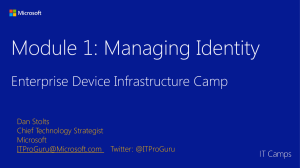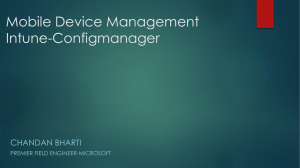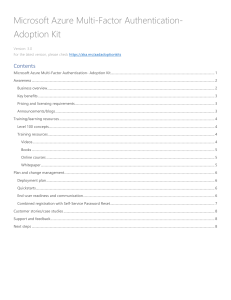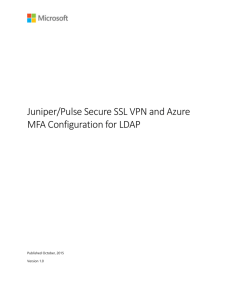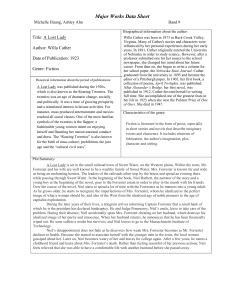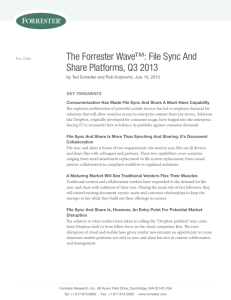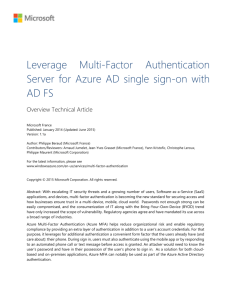Windows Server 2012R2 Capabilities for BYOD
advertisement
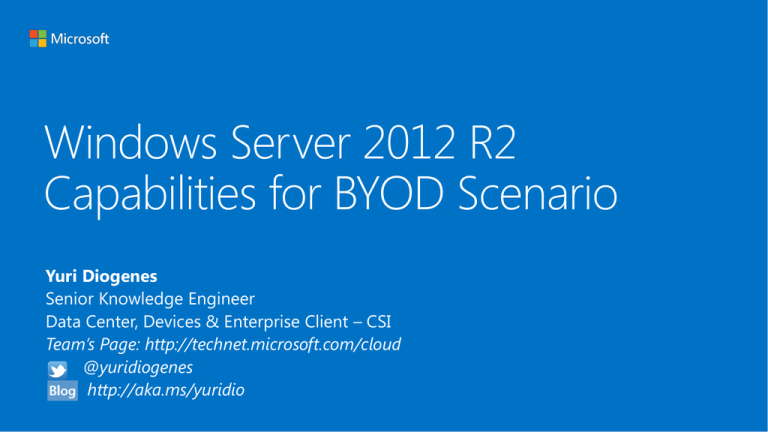
Windows Server 2012 R2 Capabilities for BYOD Scenario Yuri Diogenes Senior Knowledge Engineer Data Center, Devices & Enterprise Client – CSI Team’s Page: http://technet.microsoft.com/cloud @yuridiogenes http://aka.ms/yuridio What’s happening? Before What’s happening? Now 90% 32% GARTNER GARTNER PRESS RELEASE, GARTNER SAYS TWOTHIRDS OF ENTERPRISES WILL ADOPT A MOBILE DEVICE MANAGEMENT SOLUTION FOR CORPORATE LIABLE USERS THROUGH 2017, OCTOBER 25, 2012, HTTP://WWW.GARTNER.COM/NEWSROOM/ID/2213 115 FORRESTER RESEARCH THE STATE OF WORKFORCE TECHNOLOGY ADOPTION: GLOBAL BENCHMARK 2012, FORRESTER RESEARCH, INC., APRIL 12, 2012 of enterprises will have two or more mobile operating systems to support in 2017 of employees use two or three PCs for work from multiple locations What’s happening? Today 32% of your employees—power laptop users—access 21 different applications, while desktop users—36% of your employees—use 9.8 applications at work FORRESTER RESEARCH THE STATE OF WORKFORCE TECHNOLOGY ADOPTION: GLOBAL BENCHMARK 2012, FORRESTER RESEARCH, INC., APRIL 12, 2012 Mobility is the new normal 67% 905M of the people who use a smartphone for work and 70% of people who use a tablet for work are choosing the devices themselves tablets in use for work and home globally by 2017 FORRESTER RESEARCH BRING THE BUSINESS CASE FOR A BRINGYOUR-OWN-DEVICE (BYOD) PROGRAM, FORRESTER RESEARCH, INC., OCTOBER 23, 2012 FORRESTER RESEARCH 2013 MOBILE WORKFORCE ADOPTION TRENDS, FORRESTER RESEARCH, INC., FEBRUARY 4, 2013 Today’s challenges Users Devices Apps Data Users expect to be able to work in any location and have access to all their work resources. The explosion of devices is eroding the standards-based approach to corporate IT. Deploying and managing applications across platforms is difficult. Users need to be productive while maintaining compliance and reducing risk. Starts with a person… whose identity is verified… EMPLOYEE # 0000000-000 CONTOSO across multiple devices… with access to apps… in a consistent manner. People-centric IT Enable users Allow users to work on the devices of their choice and provide consistent access to corporate resources. Hybrid Identity Users Devices Apps Data Deliver a unified application and device management onpremises and in the cloud. Protect your data Management. Access. Protection. Help protect corporate information and manage risk. Access and Information Protection Enable users Hybrid Identity Protect your data Simplified registration and enrollment for BYO devices Automatically connect to internal resources when needed Access to company resources is consistent across devices Common identity to access resources on-premises and in the cloud Centralize corporate information for compliance and data protection Policy-based access control to applications and data Enable users Challenges Solutions Users want to use the device of their choice and have access to both their personal and work-related applications, data, and resources. Users can register their devices, which makes them known to IT, who can then use device authentication as part of providing access to corporate resources. Users want an easy way to be able to access their corporate applications from anywhere. Users can enroll their devices, which provides them with the company portal for consistent access to applications and data, and to manage their devices. IT departments want to empower users to work this way, but they also need to control access to sensitive information and remain in compliance with regulatory policies. IT can publish access to corporate resources with conditional access based on the user’s identity, the device they are using, and their location. Registering and Enrolling Devices Users can enroll devices which configure the device for management with Windows Intune. The user can then use the Company Portal for easy access to corporate applications Users can register BYO devices for single sign-on and access to corporate data with Workplace Join. As part of this, a certificate is installed on the device IT can publish access to corporate resources with the Web Application Proxy based on device awareness and the users identity. Multi-factor authentication can be used through Windows Azure Multi-Factor Authentication integration with Active Directory Federation Services. Data from Windows Intune is sync with Configuration Manager which provides unified management across both onpremises and in the cloud As part of the registration process, a new device record is created in Active Directory, establishing a link between the user and their device Publish access to resources with the Web Application Proxy Developers can leverage Windows Azure Mobile Services to integrate and enhance their apps AD Integrated Use conditional access for granular control over how and where the application can be accessed Published applications Devices Users can access corporate applications and data wherever they are Apps & Data IT can use the Web Application Proxy to pre-authenticate users and devices with multi-factor authentication through integration with AD FS Active Directory provides the central repository of user identity as well as the device registration information Make corporate data available to users with Work Folders IT can selectively wipe the corporate data from managed devices (Windows 8.1, Windows Phone 8, iOS, Android) Devices Users can sync their work data to their devices. Users can register their devices to be able to sync data when IT enforces conditional access IT can configure a File Server to provide Work Folder sync shares for each user to store data that syncs to their devices, including integration with Rights Management Apps & Data IT can publish access directly through a reverse proxy (such as the Web Application Proxy, or conditional access can be enforced through integration with AD FS Active Directory discoverability provides users Work Folders location Effective working with Remote Access An automatic VPN connection provides automated starting of the VPN when a user launches an application that requires access to corporate resources. Traditional VPNs are userinitiated and provide ondemand connectivity to corporate resources. With DirectAccess, a users PC is automatically connected whenever an Internet connection is present. Cannot originate admin connection from intranet VPN Can originate admin connection from intranet DirectAccess Connection to intranet is always active Firewall Video Demo Windows 8.1 and iPad Workplace Join and Company Portal Hybrid Identity Challenges Solutions Providing users with a common identity when they are accessing resources that are located both onpremises in a corporate environment, and in cloudbased platforms. Users have a single sign-on experience when accessing all resources, regardless of location. Managing multiple identities and keeping the information in sync across environments is a drain on IT resources. Users and IT can leverage their common identity for access to external resources through federation. IT can consistently manage identities across onpremises and cloud-based identity domains. Delivering a seamless user authentication experience Cloud Authentication Multi-Factor Authentication can be configured through Windows Azure User attributes are synchronized using DirSync including the password hash, Authentication is completed against Windows Azure Active Directory Federated Authentication with Single Sign-On AD FS provides conditional access to resources, Work Place Join for device registration and integrated Multi-Factor Authentication User attributes are synchronized using DirSync, Authentication is passed back through federation and completed against Windows Server Active Directory Protecting information with multi-factor authentication 1. Users attempts to login or perform an action that is subject to MFA 2. When the user authenticates, the application or service performs a MFA call 3. The user must respond to the challenge, which can be configured as a txt, a phone call or using a mobile app 4. The response is returned to the app which then allows the user to proceed 5. IT can configure the type and frequency of the MFA that the user must respond to Protect your data Challenges Solutions As users bring their own devices in to use for work, they will also want to access sensitive information and have access to this information locally on the device. Users can work on the device of their choice and be able to access all their resources, regardless of location or device. A significant amount of corporate data can only be found locally on user devices. IT can enforce a set of central access and audit polices, and be able to protect sensitive information based on the content of the documents. IT needs to be able to secure, classify, and protect data based on the content it contains, not just where it resides, including maintaining regulatory compliance. IT can centrally audit and report on information access. Policy based access to corporate information Desktop Virtualization IT can provide a secure and familiar solution for users to access sensitive corporate data from anywhere with VDI and RemoteApp technologies. Centralized Data Devices Users can access corporate data regardless of device or location with Work Folders for data sync and desktop virtualization for centralized applications. Distributed Data IT can publish resources using the Web Application Proxy and create business-driven access policies with multi-factor authentication based on the content being accessed. IT can audit user access to information based on central audit policies. Protect data with Dynamic Access Control Automatically identify and classify data based on content. Classification applies as files are created or modified. File classification, access policies and automated Rights Management works against client distributed data through Work Folders. Centrally manage access control and audit polices from Windows Server Active Directory. Integration with Active Directory Rights Management Services provides automated encryption of documents. Central access and audit policies can be applied across multiple file servers, with near real-time classification and processing of new and modified documents. Video Demo Work Folders with DAC and RMS For More Information System Center 2012 R2 Configuration Manager http://technet.microsoft.com/enus/evalcenter/hh667640.aspx?wt.mc_id=TEC_105_1_33 Windows Intune http://www.microsoft.com/en-us/windows/windowsintune/try-andbuy Windows Server 2012 R2 http://www.microsoft.com/en-us/server-cloud/windowsserver/windows-server-2012-r2.aspx More Resources: http://www.microsoft.com/en-us/server-cloud/solutions/accessinformation-protection.aspx http://www.microsoft.com/en-us/server-cloud/solutions/user-devicemanagement.aspx




